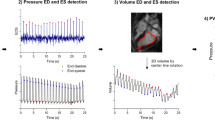Abstract
We explored the possibility of using conventional right-heart catheterization data, gathered both prospectively and retrospectively, as a surrogate for high-fidelity micromanometery when analyzing systolic and diastolic RV function and calculating various ventricular and pulmonary hemodynamic parameters in the time domain. Right heart catheterizations were performed on 13 patients (7 female), who were suspected of having pulmonary hypertension. The procedure included use of both fluid-filled catheter and high-fidelity micromanometry to measure right ventricular and pulmonary arterial pressures. A digital data acquisition system was used to record micromanometer readings and data from the fluid-filled catheter system during prospective portion of the study. Retrospective data was obtained by direct digitization of screen captures taken by the conventional clinical system (fluid-filled catheter). From the 13 patients, 12–13 RV waveforms and 12 PA waveforms were acquired from each method. Basic measurements of heart rate, systolic pressure, diastolic pressure, dP/dt max, and dP/dt min were compared between micromanometry, direct acquisition from the PA catheter (voltage acquisition), and re-digitization of the hemodynamic waveforms (tracing). Correlation between Swan and tracing was stronger than that of Millar and Swan. SBP, followed by HR, has the strongest correlation of any parameter for all three methods, while DBP appears to be the weakest. Bland–Altman analysis shows all parameters to have minimal biases that are within clinical limits. Interoperator and intraoperator variability was minimal. Digital right-heart catheterization (RHC) data can be used as a surrogate for micromanometric data under ideal conditions for hemodynamic measures in the time domain. Pre-existing RHC data can be re-digitized for more rigorous hemodynamic analysis.







Similar content being viewed by others
References
Champion, H. C., E. D. Michelakis, and P. M. Hassoun. Comprehensive invasive and noninvasive approach to the right ventricle-pulmonary circulation unit: state of the art and clinical and research implications. Circulation 120(11):992–1007, 2009.
Falsetti, H. L., et al. Analysis and correction of pressure wave distortion in fluid-filled catheter systems. Circulation 49(1):165–172, 1974.
Gould, K. L., S. Trenholme, and J. W. Kennedy. In vivo comparison of catheter manometer systems with the catheter-tip micromanometer. J. Appl. Physiol. 34(2):263–267, 1973.
Hemnes, A. R., P. R. Forfia, and H. C. Champion. Assessment of pulmonary vasculature and right heart by invasive haemodynamics and echocardiography. Int. J. Clin. Pract. Suppl. 162:4–19, 2009.
Nichols, W. W., et al. Percutaneous left ventricular catheterisation with an ultraminiature catheter-tip pressure transducer. Cardiovasc. Res. 12(9):566–568, 1978.
Ryan, J. J., et al. Current practice for determining pulmonary capillary wedge pressure predisposes to serious errors in the classification of patients with pulmonary hypertension. Am. Heart J. 163(4):589–594, 2012.
Acknowledgments
Funding for this study was provided, in part, by the National Heart, Lung and Blood Institute grant 5 P01 HL-103455-02. Hunter Champion receives research support from the Vascular Medicine Institute, the Institute for Transfusion Medicine, and the Hemophilia Center of Western Pennsylvania. Marc Simon receives research support from the American Heart Association, the Pittsburgh Foundation, and Pfizer.
Author information
Authors and Affiliations
Corresponding author
Additional information
Associate Editor Ajit P Yoganathan oversaw the review of this article.
Rights and permissions
About this article
Cite this article
Bachman, T.N., Bursic, J.J., Simon, M.A. et al. A Novel Acquisition Technique to Utilize Swan-Ganz Catheter data as a Surrogate for High-fidelity Micromanometry within the Right Ventricle and Pulmonary Circuit. Cardiovasc Eng Tech 4, 183–191 (2013). https://doi.org/10.1007/s13239-013-0124-z
Received:
Accepted:
Published:
Issue Date:
DOI: https://doi.org/10.1007/s13239-013-0124-z




